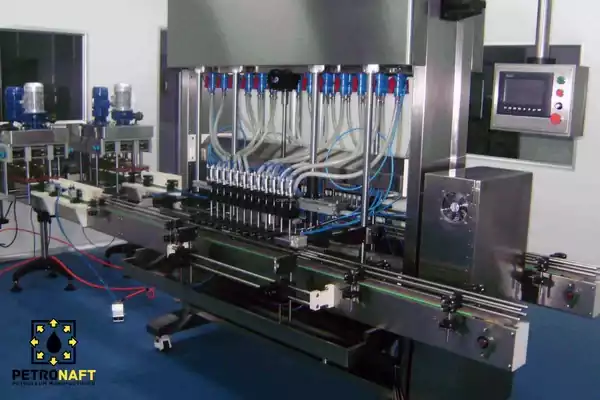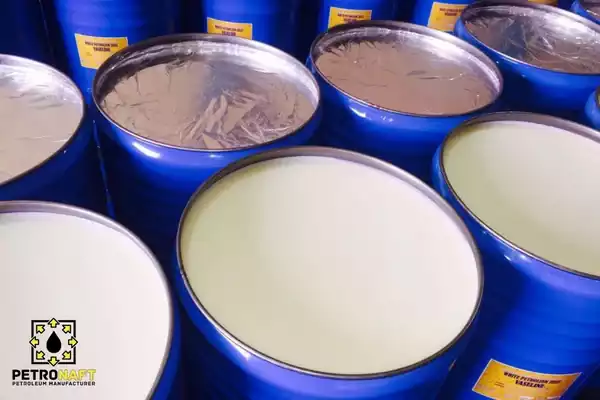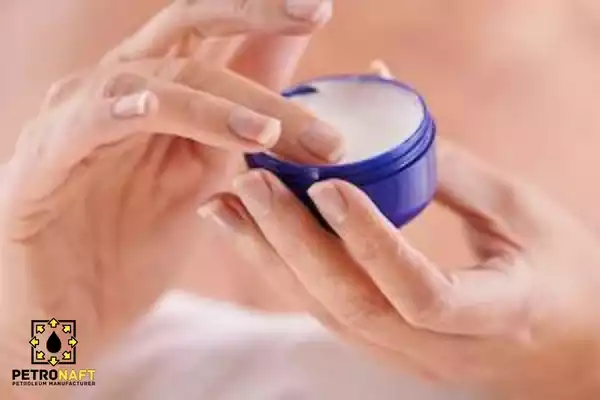PETROLEUM JELLY (VASELINE)
Content Overview
WHAT IS PETROLEUM JELLY (VASELINE)?
Petroleum jelly, also known as Vaseline or petrolatum, is a semi-solid blend of hydrocarbons derived as a byproduct from the oil refining process. PetroNaft Company provides industrial, medical, and cosmetic grades of Petroleum Jelly or Vaseline.
LIST OF PRODUCTS
PETROLEUM JELLY (VASELINE) HISTORY
From its discovery in the mid-19th century to its widespread usage in countless products today, petroleum jelly, often known under the brand name Vaseline, boasts a fascinating history.
1. Unearthing a Wonder Product In 1859, the substance now recognized as petroleum jelly was first observed by workers in Pennsylvania oil rigs. They noted the wax-like residue, which they referred to as “rod wax,” clogging up their drilling rigs, but it was also used to heal cuts and burns.
2. Refinement and Commercialization Chemist Robert Chesebrough took an interest in this “rod wax” and began conducting experiments, leading to the development of what he named “Vaseline,” a combination of the German word “wasser” for water and the Greek “elaion” for oil. By 1872, Vaseline was patented and began its commercial journey.
3. Expansion and Applications The use of petroleum jelly quickly spread due to its versatile properties. As a non-comedogenic, hypoallergenic substance that does not spoil, it became a vital ingredient in many skincare products, first-aid applications, and cosmetics. Moreover, its usage extended beyond skin care to sectors like food industry (as a release agent and in equipment maintenance), pharmaceuticals, and even aerospace.
4. Modern Day Prevalence Today, petroleum jelly, also known as mineral oil jelly, white petroleum, and petrolatum, is a staple in many households and industries around the world. Its proven skin healing benefits and versatility keep it in high demand.
PETROLEUM JELLY OTHER NAMES
Petroleum jelly is known by a variety of other names, often derived from its different brands, formulations, or uses. Here are some of the most common alternative names:
Vaseline: This is perhaps the most well-known brand name for petroleum jelly, widely used in everyday language to refer to the substance.
Petrolatum: This is another technical name for the substance, often used in industrial or scientific contexts.
White Petrolatum: This term refers to the pure, refined form of petroleum jelly that is often used in medical and personal care applications.
Mineral Jelly: Sometimes, petroleum jelly is referred to as mineral jelly, due to it being derived from mineral oil.
Paraffin Jelly: This is another term for petroleum jelly, although it should not be confused with paraffin wax, which is a different substance.
Soft Paraffin: This is often used in the United Kingdom and other parts of the world to refer to petroleum jelly.
Remember that these different names can sometimes refer to slightly different forms or uses of the substance, but they all essentially refer to the same base product: petroleum jelly.
PETROLEUM JELLY (VASELINE) PRODUCTION PROCESS
The production process of petroleum jelly (commonly known as Vaseline) is quite fascinating. Here’s a simplified step-by-step process:
1. Crude Oil Refinement
The process begins with crude oil, which is subjected to a distillation process at a refinery. This separates the oil into several components based on their boiling points. The heaviest part, known as “residuum,” is the starting point for petroleum jelly production.
2. De-waxing and De-oiling
The residuum undergoes de-waxing, a process of solvent extraction that separates the wax and oil. The wax obtained is the raw form of petroleum jelly. However, it still contains oil and other impurities.
3. Refining the Wax
To get the pure form of petroleum jelly, the wax goes through a refining process. This involves treating it with activated charcoal and clay to remove any remaining impurities and to decolorize the wax.
4. Vacuum Distillation
After refining, the wax is subjected to a vacuum distillation. This separates the different molecular weights of the wax. The heavier fractions are collected and form the basis for the finished petroleum jelly.
5. Blending
Finally, the petroleum jelly is blended with other ingredients according to the specific recipe of the finished product. This can include fragrance and color additives for cosmetic products.
6. Testing and Packaging
After the blending, the final product is tested for quality assurance before it’s packaged and distributed.
It’s important to note that the petroleum jelly you find on your store shelves, especially brands like Vaseline, undergoes rigorous purification processes to ensure it’s safe for consumer use. The final product is colorless, odorless, and doesn’t oxidize or decompose – making it an ideal ingredient in many personal care and pharmaceutical products.
PETROLEUM JELLY (VASELINE) SPECIFICATIONS
Petroleum jelly, often recognized by its popular brand name, Vaseline, is a versatile substance with specific characteristics that make it valuable across numerous industries. Here are the general specifications of petroleum jelly:
1. Appearance: Petroleum jelly is a semi-solid, clear, colorless to pale yellow product that appears glossy at room temperature.
2. Odor: Pure petroleum jelly is practically odorless. However, various scents may be added in different products, especially in the skincare industry.
3. Solubility: It is insoluble in water and alcohol but soluble in dichloromethane, chloroform, ether, and most oils.
4. Non-reactive: Petroleum jelly is stable under normal conditions and non-reactive with most chemical reagents.
5. Consistency: It has a smooth and plastic consistency that does not change in different temperatures within its operational range.
6. Melting Point: Petroleum jelly has a melting point typically within the range of 25°C to 28°C (77°F to 82.4°F).
7. Composition: It consists of a mixture of hydrocarbons, having carbon numbers predominantly greater than 25.
8. Safety: Petroleum jelly is non-comedogenic (it doesn’t clog pores) and hypoallergenic.
9. Shelf Life: It has a virtually unlimited shelf life as it doesn’t oxidize or decompose over time.
These specifications can vary slightly depending on the specific grade or formulation of petroleum jelly being used. Some brands or formulations might add different ingredients to achieve specific characteristics, such as a certain scent or color.
PETROLEUM JELLY (VASELINE) HS CODE, CHEMICAL FORMULA AND CAS NUMBER
Petroleum Jelly (also known as Vaseline) is a complex mix of hydrocarbons and does not have a specific chemical formula due to its varying composition. However, its primary components are often long chains of saturated hydrocarbons (paraffins), cyclohexanes, and aromatics.
The CAS Number (Chemical Abstracts Service Registry Number) for Petroleum Jelly is 8009-03-8.
The Harmonized System (HS) code for Petroleum Jelly varies depending on the specifics and use of the product. However, it generally falls under 2712.10 as “Petroleum jelly; paraffin wax, micro-crystalline petroleum wax, slack wax, ozokerite, lignite wax, peat wax, other mineral waxes, and similar products obtained by synthesis or by other processes, whether or not coloured”.
Please note that the HS Code can vary depending on the specific formulation of the product and its intended use. It’s always recommended to consult with a trade specialist or local customs authority to determine the correct code for your specific product.
PETROLEUM JELLY (VASELINE) PROPERTIES AND FEATURES
Petroleum jelly, commonly known by the brand name Vaseline, is a semi-solid mixture of hydrocarbons, having carbon numbers predominantly greater than 25. It possesses several notable properties and features that make it a versatile substance for various applications, including personal care, medical, and industrial uses.
1. Physical Properties:
- Appearance: It is a clear, semi-solid substance that can range in color from white to yellow depending on its level of refinement.
- Odor: Pure petroleum jelly is practically odorless, although scented versions are available in the consumer market.
- Melting Point: It has a melting point typically within the range of 25°C to 28°C (77°F to 82.4°F), which allows it to easily spread at room temperature but remain solid under most conditions.
2. Chemical Properties:
- Stability: Petroleum jelly is chemically stable, non-reactive, and resistant to most chemical reagents.
- Solubility: It is insoluble in water and alcohol but soluble in ether, benzene, and certain oil and chloroform solutions.
3. Functional Features:
- Moisturizing: It’s an excellent emollient and is used widely in the cosmetic and personal care industry for its moisturizing properties.
- Protective: It creates a waterproof barrier that protects the skin, which is why it’s commonly used for healing minor cuts and burns.
- Non-comedogenic: While it’s an oil-based product, it’s non-comedogenic, which means it doesn’t clog pores.
- Lubrication: Due to its thick consistency, it serves as a good lubricant in various applications.
- Non-irritating & Hypoallergenic: It’s generally safe for all skin types as it’s non-irritating and hypoallergenic.
These properties make petroleum jelly an essential ingredient in a wide array of products, from skincare and haircare products to ointments and lubricants. It’s the versatile characteristics and safety profile of petroleum jelly that has led to its widespread use and acceptance worldwide.
PETROLEUM JELLY (VASELINE) ADVANTAGES AND BENEFITS
Petroleum jelly, also known under the brand name Vaseline, has numerous advantages and benefits across various applications. Here are some of the most significant:
1. Skin Protection: Petroleum jelly forms a barrier on the skin, preventing moisture loss and aiding the natural recovery process of the skin. This makes it effective for healing minor cuts, burns, and scrapes.
2. Moisturization: Its occlusive properties make it a great moisturizer, especially for dry skin or lips. It’s often used in skincare products to lock in moisture and prevent dryness.
3. Safe for Most Skin Types: Petroleum jelly is non-comedogenic, hypoallergenic, and non-irritating, making it safe for most skin types.
4. Long Shelf Life: It doesn’t spoil or decompose, making it a long-lasting product that can be stored for extended periods.
5. Cost-Effective: Given its versatility and the small amounts needed for most uses, petroleum jelly offers a cost-effective solution for various skincare and industrial needs.
6. Lubrication: Petroleum jelly is a good lubricant. It’s used in a variety of applications, from beauty (like easing makeup application) to industry (like preventing rust).
7. Baby Care: It’s often used in baby care products, such as diaper rash creams, due to its mildness and skin protection properties.
8. Hair Care: Some people use petroleum jelly to lock moisture into their hair and scalp, or to style and add shine to their hair.
Despite its wide-ranging benefits, it’s essential to perform a patch test before using petroleum jelly for the first time, especially on sensitive skin, to ensure there are no adverse reactions. Also, while it’s generally considered non-comedogenic, people prone to acne or with very oily skin should use it sparingly on their face.
PETROLEUM JELLY (VASELINE) SAFETY TIPS
Petroleum jelly, such as Vaseline, is generally safe for use in many applications, from skincare to industrial uses. However, there are certain safety considerations you should keep in mind:
1. Skin Reactions: Although rare, some people may have an allergic reaction to petroleum jelly. Always perform a patch test on a small area of skin before using it more broadly, especially if you have sensitive skin.
2. Respiratory Irritation: Never use petroleum jelly inside the nostrils as it can potentially be inhaled into the lungs, leading to lung inflammation or infection.
3. Not for Internal Use: Petroleum jelly is intended for external use only. Do not ingest it, and avoid use on or near the eyes or other sensitive areas.
4. Non-comedogenic but Use Carefully on Acne-Prone Skin: Although generally non-comedogenic (does not clog pores), individuals with acne-prone or very oily skin should use it sparingly on the face as it can trap oil and bacteria, potentially causing breakouts.
5. Keep Away from Heat: Petroleum jelly is flammable. Keep it away from open flames, high heat, and do not use it for purposes such as starting a fire or barbeque.
6. Not Compatible with Latex: Petroleum jelly can weaken latex products, including condoms, potentially causing them to break.
7. Choose the Right Grade for Your Purpose: Not all petroleum jellies are the same. The highly refined white petroleum jelly (often seen in medical or skincare applications) is safe for use, but some less refined versions exist for industrial use and may not be safe for skin application.
By following these safety tips, you can use petroleum jelly effectively while minimizing potential risks. Remember, when in doubt, consult a healthcare professional or expert in the relevant field.
PETROLEUM JELLY (VASELINE) TYPES AND GRADES
1. Medical Petroleum Jelly (Pharma Grade Petroleum Jelly):
Medical or pharma grade petroleum jelly meets the highest standards of purity and safety, making it suitable for use in healthcare applications. It’s typically used in the formulation of a wide range of pharmaceutical products, including ointments, creams, and balms. This petroleum jelly variant is often a key component in first-aid applications due to its ability to protect and moisturize the skin, accelerate wound healing, and reduce scarring.
2. Cosmetic Petroleum Jelly (Cosmetic Pet Jelly):
Cosmetic petroleum jelly is a popular ingredient in many beauty and skincare products. Its high degree of refinement and safety makes it perfect for various applications, including lotions, moisturizers, hair care products, makeup, and lip balms. This petroleum jelly type is renowned for its skin softening and moisturizing properties. It helps lock in the skin’s natural moisture, preventing dryness and cracking, and forming a barrier against environmental elements.
3. Industrial Petroleum Jelly (Petroleum Jelly Industrial Grade):
Industrial grade petroleum jelly is used in a wide variety of non-medical and non-cosmetic applications. Though it’s less refined than its medical and cosmetic counterparts, it still offers various valuable properties such as lubrication and rust prevention. It’s commonly used in the automotive industry for battery terminal protection, in the leather industry for softening, in the rubber industry as a mold release agent, and in other industries for various purposes, like protection against corrosion.
Remember that each grade of petroleum jelly is designed for a specific set of uses, and it’s important to choose the appropriate grade for your needs.
PETROLEUM JELLY (VASELINE) APPLICATIONS AND USES
Petroleum jelly, often recognized by the popular brand name Vaseline, has a multitude of applications across various industries due to its unique properties. Here are some notable uses:
1. Personal Care and Cosmetics:
- Skin Care: Petroleum jelly is used as a moisturizer to prevent dry and chapped skin.
- Lip Care: It is used in lip balms to prevent chapped lips.
- Makeup: It is used as a makeup remover and can also give a glossy effect to the makeup.
2. Pharmaceutical and Medical:
- Wound Healing: It is used to protect minor cuts and burns and help them heal without leaving a scar.
- Lubrication: It is used as a lubricant in certain medical procedures.
3. Industrial Uses:
- Corrosion Prevention: It is used to prevent rust and corrosion in machinery and equipment.
- Lubrication: It serves as a lubricant in various industrial applications.
4. Other Applications:
- Leather Treatment: It is used to soften and preserve leather.
- Pet Care: It’s sometimes used to prevent paw pad injuries in dogs and cats, and can also aid in the passage of hairballs in cats.
- Hair Care: Some people use petroleum jelly to lock in moisture in their hair, prevent split ends, or manage frizz.
While petroleum jelly has numerous uses, it’s crucial to remember that not all petroleum jelly types are created equal. Always ensure you are using the appropriate grade for your specific application. For example, only pharmaceutical grade petroleum jelly should be used for medicinal applications, and only cosmetic grade for personal care and cosmetic applications.
HOW TO USE PETROLEUM JELLY (VASELINE)?
The usage of Petroleum Jelly, widely known as Vaseline, varies based on its grade and intended application. Here are the general guidelines for using each type:
1. Medical Petroleum Jelly (Petroleum Jelly Pharma Grade):
Medical or pharma-grade petroleum jelly is often used in wound care and other medical applications.
Wound Care: After cleaning and drying the affected area, apply a thin layer of pharma-grade petroleum jelly. This will keep the wound moist, promoting faster healing and reducing scarring. Cover the area with a sterile bandage.
Skin Protection: Apply a thin layer of petroleum jelly to areas prone to chafing or friction during physical activities.
Always follow the instructions of a healthcare professional when using medical-grade petroleum jelly.
2. Cosmetic Petroleum Jelly (Cosmetic Pet Jelly):
Cosmetic petroleum jelly is intended for skincare and cosmetic uses.
Skin Care: After cleansing, apply a thin layer of cosmetic petroleum jelly to the skin to lock in moisture and prevent dryness.
Lip Care: Apply a small amount to the lips to prevent chapping. It can be reapplied throughout the day as necessary.
Makeup Removal: Apply petroleum jelly to a cotton pad and gently rub over the face to remove makeup.
Remember to always perform a patch test to ensure no allergic reaction when using it for the first time.
3. Industrial Petroleum Jelly (Petroleum Jelly Industrial Grade):
Industrial-grade petroleum jelly is used in various non-cosmetic and non-medical applications.
Corrosion Prevention: Apply a layer of petroleum jelly on the surface of tools or machinery to prevent rusting.
Lubrication: Apply where necessary to reduce friction between moving parts.
When using industrial-grade petroleum jelly, always follow safety guidelines, especially in the workplace.
PETROLEUM JELLY (VASELINE) COMPONENTS AND MATERIALS
Petroleum jelly, often referred to by the brand name Vaseline, is made from a blend of mineral oils and waxes. The exact composition can vary depending on the specific product and its intended use, but all petroleum jelly products are a mixture of hydrocarbons.
The main components include:
1. Mineral Oils: These are distilled from petroleum and are used to give the jelly its semi-solid state.
2. Microcrystalline Wax: This is a type of wax produced from petroleum that helps give petroleum jelly its characteristic texture.
3. Paraffin Wax: This is another type of wax derived from petroleum that adds to the thickness and stability of the final product.
In the refinement process, these components are filtered and purified to remove impurities. This creates a translucent, non-reactive product that’s safe for a wide variety of uses. The product is also decolorized to give it its signature clear or slightly yellow color.
It’s important to note that while all petroleum jelly is composed of a mixture of these hydrocarbons, the specific formulation can vary. For instance, pharmaceutical-grade petroleum jelly is made to a high degree of purity to ensure it’s safe for medical use, while cosmetic-grade petroleum jelly might be combined with other ingredients to enhance its skincare properties. Industrial-grade petroleum jelly, on the other hand, may not be as thoroughly purified, since it’s intended for non-cosmetic and non-medical uses. Always be sure to use the appropriate grade of petroleum jelly for your specific application.
PETROLEUM JELLY (VASELINE) DURABILITY
Petroleum jelly, commonly known as Vaseline, is known for its long shelf life and durability. When stored properly, a jar of petroleum jelly can last for several years.
Here are some factors that contribute to its durability:
1. Chemical Stability: Petroleum jelly consists of a mixture of hydrocarbons that are chemically stable, meaning they do not easily react with other substances or break down over time.
2. Absence of Water: Petroleum jelly does not contain water. This makes it less susceptible to the growth of bacteria or fungi, which can cause products to spoil or degrade.
3. Sealed Storage: Petroleum jelly remains in good condition when stored in a tightly sealed container that prevents contamination from dirt, dust, or other substances.
4. Temperature Resistant: Petroleum jelly does not freeze in cold temperatures or evaporate in hot conditions, adding to its durability.
Remember, while petroleum jelly is durable, it’s important to use it hygienically to avoid contamination. Always use clean hands or a clean tool when scooping out petroleum jelly from its container, and keep the jar tightly sealed when not in use. The usability of petroleum jelly is not usually defined by its expiry date, but rather by any change in its color, texture, or smell. If you notice any such changes, it’s best to discard the jar and get a new one.
Please also note that this information might not apply to petroleum jelly products that are mixed with other ingredients, as those ingredients could affect the overall shelf life of the product. Always check the manufacturer’s recommendations on the packaging.
PETROLEUM JELLY (VASELINE) PERFORMANCE
Petroleum Jelly, often referred to by the popular brand name Vaseline, is celebrated for its versatile performance in various applications. Its effectiveness can be attributed to its unique physical and chemical properties.
Here’s a closer look at its performance in different uses:
1. Moisturizing: Due to its occlusive properties, petroleum jelly forms a protective barrier on the skin, preventing moisture loss. This makes it a highly effective moisturizer, particularly for dry or chapped skin and lips.
2. Wound Healing: In the medical field, petroleum jelly is often used for minor wounds. It creates a moist environment that can help wounds heal faster and with less scarring compared to dry healing.
3. Makeup Removal: As an oil-based product, petroleum jelly can effectively remove makeup, including waterproof varieties. It also leaves the skin feeling soft and moisturized.
4. Protection: Petroleum jelly can provide a protective barrier against environmental factors. For example, it can protect skin from windburn and chapping in harsh weather conditions.
5. Lubrication: The slippery consistency of petroleum jelly makes it a good lubricant. It can reduce friction between surfaces, making it useful in various industrial applications.
6. Corrosion Prevention: When applied to the surface of metals, petroleum jelly can help prevent rust and corrosion by blocking exposure to air and moisture.
Overall, the performance of petroleum jelly largely depends on its intended use. Different grades (e.g., pharmaceutical, cosmetic, and industrial) are specifically formulated to deliver optimal performance in their respective applications. Always ensure you are using the appropriate grade for your specific application.
PETROLEUM JELLY (VASELINE) MAINTENANCE
Maintaining the quality and usability of petroleum jelly, often known as Vaseline, involves simple steps. Here are some recommendations:
1. Store Properly: Keep the petroleum jelly in a cool, dry place away from direct sunlight. Excessive heat can degrade the quality of the product and alter its consistency.
2. Keep It Sealed: Always secure the lid of the petroleum jelly container when not in use. This will prevent contamination from dirt, dust, or moisture.
3. Use Clean Tools: When applying petroleum jelly, use clean hands or applicators. This minimizes the introduction of bacteria or other contaminants into the jar.
4. Avoid Mixing Products: Don’t mix petroleum jelly with other products unless guided by a professional or a reliable source. Some substances might not be compatible and could alter the quality and effectiveness of the petroleum jelly.
5. Observe for Changes: Regularly check the petroleum jelly for any changes in color, texture, or smell. If you notice any such changes, it might indicate that the product has degraded and should be discarded.
Remember, while petroleum jelly has a long shelf life and is relatively stable, it should still be used hygienically and stored properly to maintain its quality and effectiveness. This applies to all grades of petroleum jelly, whether it’s intended for medical, cosmetic, or industrial use.
PETROLEUM JELLY (VASELINE ) PRICE
Understanding Global Petroleum Jelly Prices: A Must-Read Comprehensive Guide for Better Comprehension
Pricing Trends in Petroleum Jelly: Overview
PETROLEUM JELLY (VASELINE) PACKAGING
- Medical Petroleum Jelly is usually packed in new 175-kg steel drums. But we can provide other packing types for esteemed customers, such as second-hand drums, Iso Tank and Flexi Tank.
- Cosmetic Petroleum Jelly is usually packed in new 175-kg steel drums and new PE drums. But we can provide other packing types for esteemed customers, such as second-hand drums, Iso Tank and Flexi Tank.
- Industrial Petroleum Jelly is usually packed in new or used 175 kg drums, ISO tanks, and Flexi tanks.
PETROLEUM JELLY (VASELINE) TRANSPORTATION AND STORAGE
Transportation and storage of Petroleum Jelly (Vaseline) should always adhere to specific guidelines to maintain product integrity, regardless of the grade or application. Here are some considerations for the three mentioned packaging methods:
1. Steel Drums (New or Second-Hand):
- Medical Petroleum Jelly and Cosmetic Petroleum Jelly are usually packed in new 175-kg steel drums, while Industrial Petroleum Jelly might be packed in new or used ones.
- Steel drums should be stored in a cool, dry place away from direct sunlight or extreme temperature fluctuations.
- During transportation, drums should be securely fastened to avoid movement and potential damage.
- Drums should be handled with care to prevent any dents or damages that could compromise the seal and potentially contaminate the product.
2. Iso Tanks:
- An option for bulk transport and storage of Petroleum Jelly.
- Iso Tanks should be properly cleaned and sterilized before filling to avoid any cross-contamination.
- The temperature during transport should be regulated as per product specifications to prevent the jelly from overheating or freezing.
3. Flexi Tanks:
- An economical solution for the bulk transport of non-hazardous liquids like Petroleum Jelly.
- Flexi Tanks should be installed correctly within a standard shipping container to prevent leaks and spills.
- Similar to Iso Tanks, the temperature should be regulated to maintain the product’s quality.
In general, irrespective of the packaging method, all petroleum jelly products should be stored in a cool, dry, and well-ventilated area away from direct sunlight, heat sources, and incompatible materials. Proper handling and storage methods should be followed to ensure the product’s quality and safety.
Explore related articles on this product via the tag link below:
Articles Related to Petroleum Jelly
For more information, please click on each product listed below.
PETROLEUM JELLY (VASELINE) Products
INDUSTRIAL PETROLEUM JELLY
INTRODUCTION OF INDUSTRIAL PETROLEUM JELLY Industrial Petroleum Jelly is a hydrocarbon compound that is semi-solid,
COSMETIC PETROLEUM JELLY
INTRODUCTION OF COSMETIC PETROLEUM JELLY Cosmetic petroleum jelly is a highly refined semi-solid petrolatum material
MEDICAL PETROLEUM JELLY
INTRODUCTION OF MEDICAL PETROLEUM JELLY Medical Petroleum jelly, also known as Petroleum jelly pharma grade,
Frequently Asked Questions About PETROLEUM JELLY
Petroleum Jelly is a translucent jelly consisting of a mixture of hydrocarbons and is used as a lubricant or ointment.
True, Vaseline has several advantages, but it is only intended for exterior use. Avoid ingesting or consuming Vaseline orally. Never use Vaseline as a vaginal lubricant or for sexual relations. A study of 141 women revealed that 17% of them had used vaginal Vaseline and 40% had bacterial vaginosis.
Vaseline may cause a variety of adverse responses, such as:
1- Allergy:
Some individuals who use petroleum compounds are more sensitive and develop allergies. Always be on the lookout for symptoms of allergic reactions while using new goods.
2- Infection:
Before using Vaseline, thoroughly dry and cleanse the targeted area's skin; otherwise, fungal or bacterial infections may develop. Remember that if you touch the can of Vaseline with an infected hand or if you use Vaseline in the genital region, it is possible to contaminate the contents of the can.
3- Aspirational dangers:
Consult a physician before applying Vaseline to the regions around the nose. In particular, in young people, inhaling mineral oils may cause aspiration pneumonia.
4- Pore blockage:
Some individuals acquire boils using Vaseline. Before using Vaseline, your skin should be completely cleansed; this will lessen the likelihood of outbreaks.
Vaseline is a health product used directly or indirectly by the majority of people for skin protection. Although Vaseline and Petroleum Jelly have a shared ancestry, the issue arises as to what the distinction between these two compounds is. In actuality, Petroleum Jelly is the key component in the creation of Vaseline, with the exception that the purity of Vaseline is greater owing to its use in health applications, and it has undergone some kind of purifying procedure. However, Petroleum Jelly is mostly utilized for industrial reasons, and for health purposes, it is seldom ever used. Petroleum Jelly is yellow because it contains numerous contaminants, while Vaseline is white.
Vaseline is often manufactured with lavender or baby powder-scented essential oils by companies that manufacture health goods. This permits its application to the skin and hair. On the other hand, Petroleum Jelly smells like oil or gas, which shows that the natural environment is its main source.
To download the TDS of Petroleum Jelly, you can click the "INFORMATION REQUEST AND PRODUCT SAMPLE" button below the product photos. We will send you the necessary information as soon as possible, or use the "ANY QUESTION?" form on the bottom right of the page.
To download the specification PDF of Petroleum Jelly, you can click the "INFORMATION REQUEST AND PRODUCT SAMPLE" button below the product photos. We will send you the necessary information as soon as possible, or use the "ANY QUESTION?" form on the bottom right of the page.
To download the MSDS of Petroleum Jelly, you can click the "INFORMATION REQUEST AND PRODUCT SAMPLE" button below the product photos. We will send you the necessary information as soon as possible, or use the "ANY QUESTION?" form on the bottom right of the page.








Hello
Do you also provide Snow White petroleum jelly? If yes, please provide an explanation.
Yes, we provide Snow White Petroleum Jelly with the best possible quality and price. To get more information about this product, please click on the following phrase, and you can also contact us to purchase.
SNOW WHITE PETROLEUM JELLY